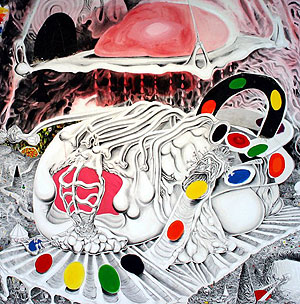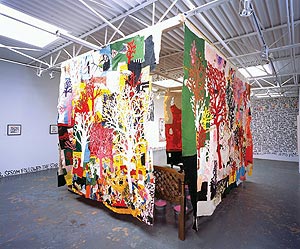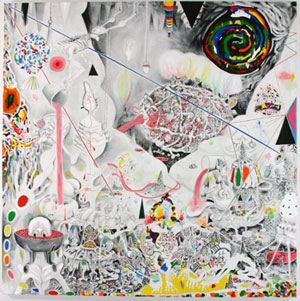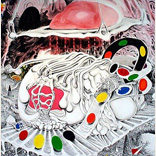The madman prophet storyteller Trenton Doyle Hancock has arrived once again in Dallas.
He has woven together narrative and material wonder, filling Dunn and Brown with his newest installation, St. Sesom and the Cult of Color. This is a spectacle. But on closer look there are undercurrents of race, religion, and even a critique of white liberalism that hover beneath the surface.
On one side of the gallery there is a bedroom, made of walls pieced together with felt, crusty glue and detritus like fake flowers, bottle caps, and juice cartons. These fragile walls hang suspended from the ceiling. Inside there is a chest of drawers, a vanity and a bed frame. In place of a mattress there are 9 aluminum buckets of bright pink Pepto Bismol. The sweet scent of the antacid mixes with music that wafts from speakers hidden inside the furniture. The songs are bound by the theme of color: “Brown Eyed Girl,” “The Pink Panther” and the theme from “Pocahontas.”
Outside of this Bedouin enclosure — a site of dreams — are a series of drawings and wall text that begin the latest chapter in Hancock's ongoing mythology. The story picks up with Sesom, a freethinking vegan minister. Vegans have lost the ability to see because of inbreeding. Sesom can see but he can't see color in his dreams. He thought that there was more to life than black and white so he went in search of the mounds. He stopped to meditate and fell into a trance. Suddenly, colored beams of light projected from him towards the sky, exploding like fireworks and radiating like stars in the heavens. Then Sesom walked. He walked for 44 days and 44 nights until he bumped into a mound. But not any mound, this was the number one mound, known as the Legend who gave him a gift of mound meat, which he stuffed into his pockets.
Through paintings, drawings, and prints, Hancock uses the tension between grayscale and color as both an allegory of painting and a way to explore the politics of race. The images separate between value and chroma as if stacked on top of one another. Back and white drawing serves as the understructure upon which the flesh of color is laid.
At one time, drawing and color were thought of quite literally this way: drawing was more cognitive and color had more to do with feeling. Feminist art historians explain that these attributes have been seen both in terms of gender and race. One opinion has it that men are more likely to think in terms of structure and women more likely to gravitate toward feeling and consequently color. Similar to this position is a myth about people of color which links the increased pigment of skin tone with the idea of unbridled passion and feeling — a Romantic assumption that influenced early modern artists like Picasso to use African sculpture as inspiration for more feeling in his work.

Trenton Doyle Hancock...Miracle Machine # 9...or The Furnace That Burned Together Goodness... 2005... Mixed media on canvas...60 x 60 inches
Trenton Doyle Hancock, (a regal name if I ever heard one) has infused this story with biblical allusions, conscious or not. There are many stories of prophets, stopping to meditate and dream. Jacob dreamed of a ladder of angels, Jesus faced his demons in the Garden of Gethsemane and the Buddha achieved enlightenment under a tree. The story of walking and then stopping and bumping into a place lies closest to the story of Jacob. And strangely enough, it is his favorite son that later wears the Technicolor dream coat of Broadway fame. The prophet analogy is one that also plagues artists. The artist as shaman or mystic that acts as a medium for truth is an idea that has traveled from Fra Angelico praying over his paintbrush to Pollock declaring “I am nature” as he mimicked the act of making native American sand paintings.
There's a sense of humor and even childish play, from the wacky colors to the strange harmonics of the music that softens the directness of these allusions. Is this satire? Is it critique? I would venture to say that it's a little bit of both. The colorless vegans that have been inbreeding for so long that they can't see…This seems to me like a hilarious dig at white hippie liberals, preaching to the choir for generations, their skin softened by Birkenstocks and petuli oil for years. They claim not to see difference but as a result are blind. Because in this world, light refracts into both color and tone and at the very least it allows us to see this bizarre and beautiful show.
Images courtesy Dunn and Brown Contemporary.
Noah Simblist is an artist and writer who lives in Dallas and teaches at SMU.





